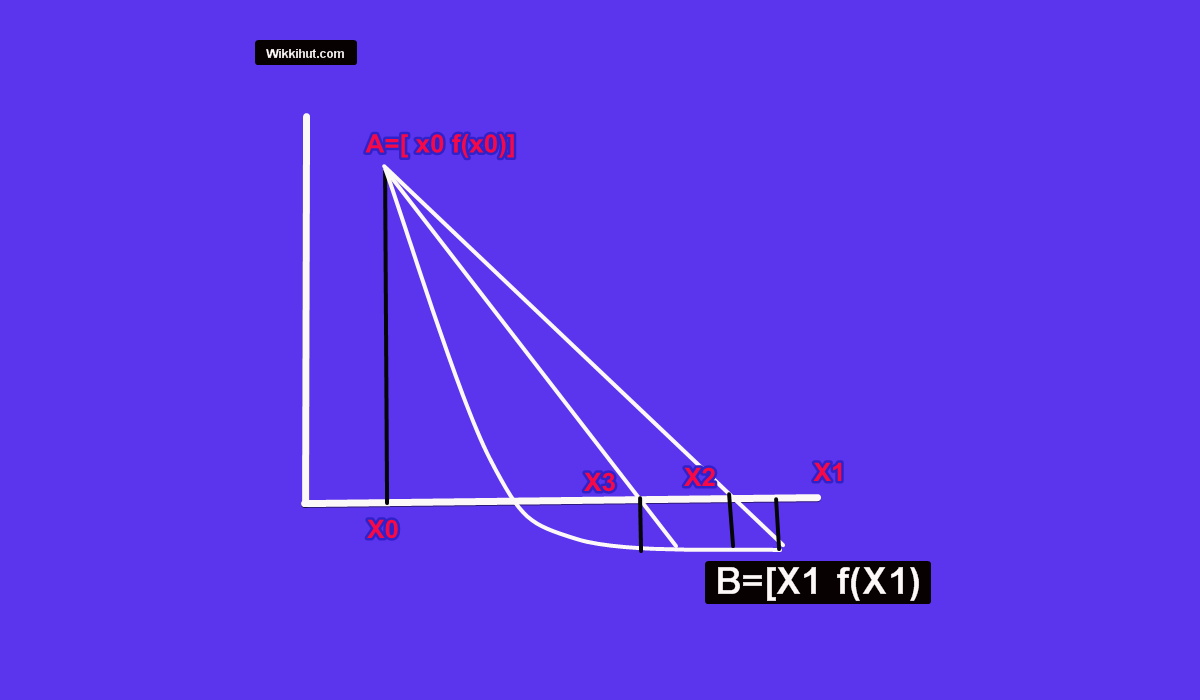
The Regula Falsi Method stands as a powerful tool for approximating the roots of mathematical equations.
Specifically, it is an algorithm used to find the solutions to equations by narrowing down the search range iteratively.
In this blog post, we will delve into the implementation of the Regula Falsi Method using the C++ Program and Example.
The Regula Falsi Method in C++: A Simplified Approach to Root-Finding
Regula Falsi Method C++
Method of False Position
The Regula-Falsi method is also called the Method of False Position, closely resembles the Bisection method.
This is the oldest method of finding the real root of an equation.
Regula falsi method has linear rate of convergence which is faster than the bisection method.
Related: Newton Raphson Method C++
Regula Falsi Method C++ Program
//Regula Falsi method
//techindetail.com
#include<iostream>
#include<math.h>
#include<iomanip>
using namespace std;
float f(float x)
{
return cos(x)-x*exp(x);
}
void regula (float *x, float x0,float x1, float fx0,float fx1, int *itr)
{
*x=x0-((x1-x0)/(fx1-fx0))*fx0;
++(*itr);
cout<<" Iteration No."<<setw(3)<<*itr<<"\t X= "<<setw(7)<<setprecision(5)<<*x<<endl;
}
int main()
{
int itr=0, maxitr;
float x0,x1,x2,x3,aerr;
cout<<"\nEnter the value of x0: ";
cin>>x0;
cout<<"\nEnter the value of x1: ";
cin>>x1;
cout<<"\n enter allowed error: ";
cin>>aerr;
cout<<"\n maximum iterations: ";
cin>>maxitr;
cout<<endl;
regula(&x2,x0,x1,f(x0),f(x1),&itr);
do
{
if(f(x0)*f(x2)<0)
x1=x2;
else
x0=x2;
regula(&x3,x0,x1,f(x0),f(x1),&itr);
if(fabs(x3-x2)<aerr)
{
cout<<"After "<<itr<<" iterations, root = "<<x3<<endl;
return 0;
}
x2=x3;
}
while(itr<maxitr);
cout<<"Solution does not converge"<<endl;
cout<<"Iterations are not sufficient"<<endl;
return 1;
}Code language: C++ (cpp)Read More: Gauss Jordan Method C++
Example
Find a real Root of equation f(x)=x3-2x-5 by the method of false position method ( Regula Falsi method ).
let f(x)=x3-2x-5 and we have to find its real root correct to three decimal places.
if we put x=2 and x=3, we find f(2) is negative and f(3) is positive.
it means the root lies between 2 and 3.
therefore, taking
x0 = 2
x1 = 3
f ( x0 ) = -1 and
f ( x1 ) = 16
in equation (2) we get
x2 = 0.0588
Now f(x2) = f( 0.0588 ) = -0.3982
i.e., the root lies between 2.0588 and 3.
Therefore, taking
x0 = 2.0588
x1 = 3
f ( x0 ) = -0.3908
f ( x1 ) = 16 in eq. (2)
we get, x3 = 2.0813
By repeating this process, the successive approximations are
x4=2.0682 x5=2.0915
.
.
.
x7=2.0941 and
x8=2.0943
and therefore the root is 2.094
Suggested Read:
Graphical explanation.

As in the picture we use two points x0 and x1 such that f(x0) and f(x1) have opposite signs, that is the graph
y=f(x)
cuts the x-axis at least once while going from x0 to x1, which indicates that the root lies between x0 and x1 .
Now we connect the two points f(x0) and f(x1) by a straight line.
The equation of the straight line joining these points is :

This straight-line cuts the x-axis at point x2,
this point where the line (1) cuts the x-axis is taken as an approximation to the root.
At this point Y=0 and X=x2 put the value of Y and X in (1) we get:

which is an approximation to the root. see more
Find f(x2).
If f(x2) and f(x0) are of opposite signs then we replace x1 by x2 and draw a straight line connecting
f(x2) to f(x0)
to find the new intersection point.
If f(x2) and f(x0) are of the same sign then x0 is replaced by x2 and proceed as before.
In both cases, the new interval of search is smaller than the initial interval and ultimately convergence is guaranteed.
Read More: Gauss elimination with Partial Pivoting C++
Algorithm for Regula-falsi method:
- read x0 & x1, two initial guesses.
- Enter Allowed error and Max iterations.
- Take x0=1 & x1=3
- f(x0)=-0.3908 and f(x1)=16, in equation (2) we get x3=2.0813
- (x0) and f(x1) are not same.
- f0=f(x0)
- f1=f(x1)
- for i=1 to n in steps of 1 do
- x2=(x0f1-x1f0)/(f1-f0)
- f2=f(x2)
- if |f2|<e then
- begin Write ‘convergent solution’, x2,f2
- stop end
- if sign (f2)=sign f(0)
- then begin x0=x2
- f0=f2
- else begin x1=x2
- f1=f2
- write ‘Does not converge in n iterations’
- write x3,f2
- stop
Related:
- Linear Regression
- Polynomial Regression
- Maclaurin Series Formula
- Taylor Series Formula
- Langranges Interpolation
- Newtwon’s Forward Differnce Interpolation
